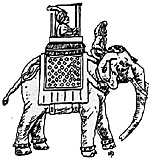- "Wot makes the soldier's 'eart to penk, wot makes 'im to perspire?
It isn't standin' up to charge nor lyin' down to fire;
But it's everlastin' waitin' on a everlastin' road
For the commissariat camel an' 'is commissariat load."
Read any account of a British army in India and you will find it will emphasise the colossal number of baggage animals and camp followers that accompanied the army on its march. The number of followers frequently outnumbered fighting men by a considerable margin. In some circumstances, a large proportion of the army had to be excluded from combat by the necessity of guarding the baggage lines.
 So, how big is the baggage train for your colonial army? Not very big at all?
So, how big is the baggage train for your colonial army? Not very big at all?
In many ways, colonial warfare is a gift to the solo wargamer. Forces are often small, and much of the player's effort goes into the planning and organisation of his punitive expedition and the logistics of getting it from A to B. But when the army meets some resistance and figures are placed on the table, the baggage train often dwindles or disappears, doesn't it? Be honest!
The following idea is intended to ensure that your colonial army retains its correct proportions, even in the face of the enemy. It can also, believe it or not, take the place of conventional army lists; you can have as many units as you like, so long as you field the requisite amount of baggage with it.
Each type of unit must field a set number of four wheeled wagons or their equivalent:
- An Indian infantry battalion or mountain battery must have one wagon.
A British infantry battalion, Indian cavalry regiment or field battery must have two wagons.
A British cavalry regiment or heavy battery requires three wagons.
A Foot Guards battalion or Household Cavalry regiment (Not in India) needs four wagons.
Smaller units, e.g. pioneer companies, troops of guides, bands of irregular horse, need the equivalent of half a wagon.
In addition, throw a D6 for each unit commander. If 6, the commander is particularly fond of keeping a good table: add an extra wagon.
To give the baggage train a more irregular feel, any wagon could be substituted by the following:
- Two two-wheeled wagons or two pack elephants.
Four pack camels.
Six pack horses, oxen or mules.
Eight porters.
It soon becomes obvious that if your army contains a large proportion of high class troops, they have more baggage than they can guard. The wisest option, therefore, is to go for plenty of native infantry, with just a stiffening of British troops.
Of course, it could be a bit expensive to rush out and buy all these wagons, camels and char wallahs in one go. I managed to put together quite a convincing Indian baggage train from the odds and ends in my spares box, which contains the accumulated rubbish of many different armies, with just a handful of wagons to "fill it out". I had some old Peter Laing Indian infantry in there, which carved up nicely into porters, and I begged and scrounged the odd camel from wargaming mates who had old figures they no longer felt were fit to be seen on the table. It often doesn't matter how bad these are - they are very difficult to see when you've stuck balsa boxes and rolls of paper all over them. Actually, I had great fun converting the figures into various characters including, of course, bearing his water skin, the regimental bhisti wallah, Gunga Din.
Back to Table of Contents -- Lone Warrior #124
Back to Lone Warrior List of Issues
Back to MagWeb Magazine List
© Copyright 1998 by Solo Wargamers Association.
This article appears in MagWeb (Magazine Web) on the Internet World Wide Web.
Other military history articles and gaming articles are available at http://www.magweb.com
